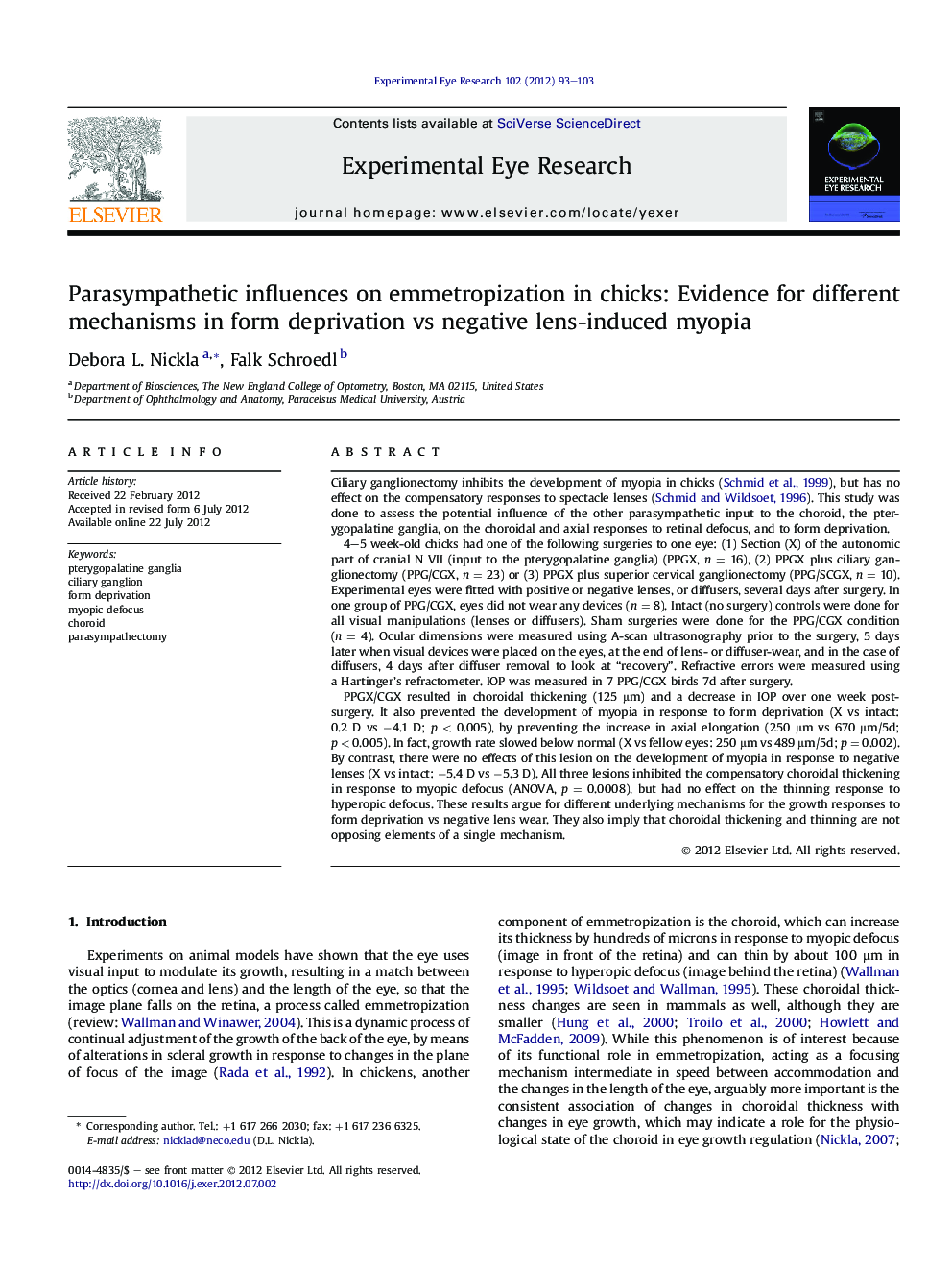| کد مقاله | کد نشریه | سال انتشار | مقاله انگلیسی | نسخه تمام متن |
|---|---|---|---|---|
| 4011306 | 1602620 | 2012 | 11 صفحه PDF | دانلود رایگان |

Ciliary ganglionectomy inhibits the development of myopia in chicks (Schmid et al., 1999), but has no effect on the compensatory responses to spectacle lenses (Schmid and Wildsoet, 1996). This study was done to assess the potential influence of the other parasympathetic input to the choroid, the pterygopalatine ganglia, on the choroidal and axial responses to retinal defocus, and to form deprivation.4–5 week-old chicks had one of the following surgeries to one eye: (1) Section (X) of the autonomic part of cranial N VII (input to the pterygopalatine ganglia) (PPGX, n = 16), (2) PPGX plus ciliary ganglionectomy (PPG/CGX, n = 23) or (3) PPGX plus superior cervical ganglionectomy (PPG/SCGX, n = 10). Experimental eyes were fitted with positive or negative lenses, or diffusers, several days after surgery. In one group of PPG/CGX, eyes did not wear any devices (n = 8). Intact (no surgery) controls were done for all visual manipulations (lenses or diffusers). Sham surgeries were done for the PPG/CGX condition (n = 4). Ocular dimensions were measured using A-scan ultrasonography prior to the surgery, 5 days later when visual devices were placed on the eyes, at the end of lens- or diffuser-wear, and in the case of diffusers, 4 days after diffuser removal to look at “recovery”. Refractive errors were measured using a Hartinger's refractometer. IOP was measured in 7 PPG/CGX birds 7d after surgery.PPGX/CGX resulted in choroidal thickening (125 μm) and a decrease in IOP over one week post-surgery. It also prevented the development of myopia in response to form deprivation (X vs intact: 0.2 D vs −4.1 D; p < 0.005), by preventing the increase in axial elongation (250 μm vs 670 μm/5d; p < 0.005). In fact, growth rate slowed below normal (X vs fellow eyes: 250 μm vs 489 μm/5d; p = 0.002). By contrast, there were no effects of this lesion on the development of myopia in response to negative lenses (X vs intact: −5.4 D vs −5.3 D). All three lesions inhibited the compensatory choroidal thickening in response to myopic defocus (ANOVA, p = 0.0008), but had no effect on the thinning response to hyperopic defocus. These results argue for different underlying mechanisms for the growth responses to form deprivation vs negative lens wear. They also imply that choroidal thickening and thinning are not opposing elements of a single mechanism.
► Parasympathectomy prevents the development of deprivation myopia by inhibiting eye growth.
► Parasympathectomy has no effect on the axial compensation to lens-induced defocus.
► Parasympathectomy inhibits the choroidal thickening response to myopic defocus.
Journal: Experimental Eye Research - Volume 102, September 2012, Pages 93–103